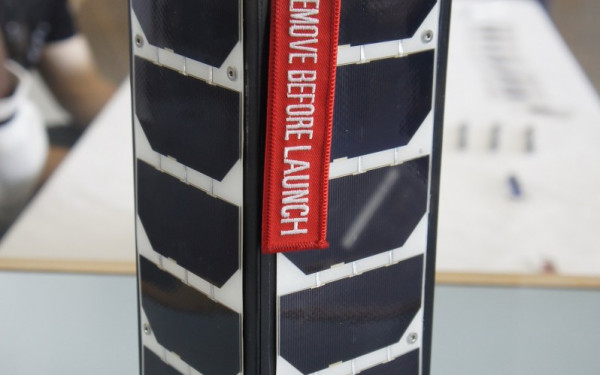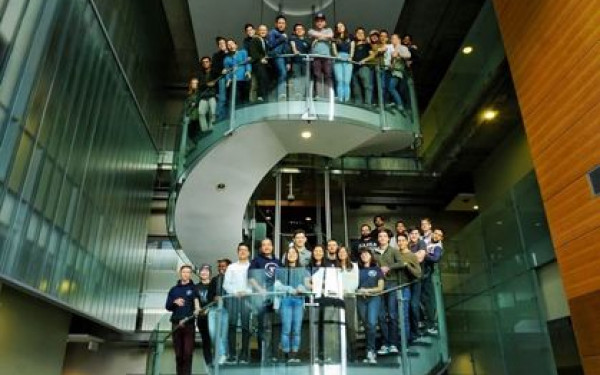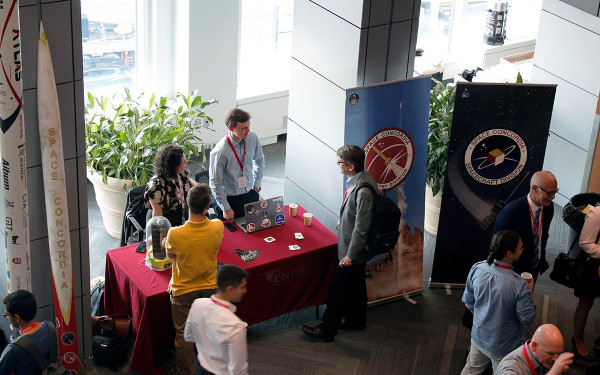Concordia Students Space Out
Or, How to Map a Plasma Cloud—On a Budget
Approximately 200 km above the South Atlantic Ocean rests a strange and often dangerous phenomenon, one that has baffled and intrigued scientists, pilots and astronauts since its discovery the late 1950s—a plasma cloud of super-charged radiation dubbed the South Atlantic Anomaly.
Concordia’s astronautical engineering team, Space Concordia, is trying to map that anomaly. Earlier this month, the team won the first-ever Canadian Satellite Design Challenge—making Concordia the first Quebec university to go to space.
“It’s just so interesting,” said Nick Sweet, Concordia engineering student and team lead. “The first time I heard about the anomaly I thought of it like a sort of space-Bermuda Triangle.”
After two years of working on nanosatellite technology and design, Sweet and his crew of volunteers, mostly undergraduate students, made a breakthrough.
The team’s project was to design, build and hopefully launch a CubeSat—a miniature satellite built with mostly off-the-shelf components.
The term “CubeSat” comes from the satellite’s typical dimensions—10×10×10 cm—known as a 1U CubeSat model. The team at Space Concordia however will be launching a slightly larger 3U model, with 34×10×10 cm dimensions.
The satellite looks like a really expensive shoebox layered with solar panels and crammed with complicated gadgetry.
“With the payload we have, the 3U is sufficient,” said PhD student Michelle Boyce, the team’s payload lead.
The Space Concordia team needs that extra payload space to complete their mission: testing and mapping out the harsh radiation of the South Atlantic Anomaly with the hopes of gaining a better understanding of its relationship with space weather.
The South Atlantic Anomaly
Consider the earth as a giant, spherical bar-magnet.
“The problem is that the centre of the magnet is not at the centre of rotation of the earth,” explained Boyce. “It’s shifted higher, it’s slightly off-axis, and what that causes is a concentration of magnetic field lines closer to the earth. That’s the South Atlantic Anomaly.”
Particles that travel in a magnetic field tend to move in a curved path. The curvature of that path is dependent on the mass of the particles, how fast they’re moving, and the strength of the magnetic field.
Wrapping around the earth are a series of electromagnetic fields that trap particles and cause what are known as the Van Allen radiation belts.
“Because of all the sources of energy in our solar system, there is a belt of protons going around the earth, and a smaller belt of electrons also going around the earth but in the opposite direction,” said Boyce. “Our interest is here, in the inner Van Allen belt.”
The inner Van Allen belt circles around the earth at an orbit of approximately 600 km. However, as Boyce explains, the inner belt is an elaborate system.
“You get a much more complex plasma tail due to solar radiation,” said Boyce. “This causes particles to accelerate into [the inner Van Allen belt] and feed the system. There is an unusual concentration at the SAA because that is where the field lines are more concentrated and closer to the earth.”
The reason that the inner belt has so many protons is partly due to the Sun, because it’s mostly composed of hydrogen, and protons are hydrogen atoms.
When there is solar activity, or solar flares, the earth collects more protons into the Van Allen Belts, which can cause the SAA to grow.
These changes in the anomaly are what Space Concordia is hoping to figure out.
“If we can count the actual rate of particles going through the satellite’s radiation detector we can calculate the density of the SAA,” said Boyce. “If we correlate that with solar activity, we can measure space weather.”
_900_600_90.jpg)
The Dangers of Space Weather
“Space weather has a big effect on us, especially on aircrafts, which are flying higher these days,” said Boyce. “When they’re up at those altitudes, the radiation can affect their electronics.”
The high density of radiation within the anomaly has reportedly caused severe malfunctions in the electronics of planes, space shuttles and satellites.
Some pilots have reported extreme turbulence when flying through the anomaly. Astronauts have reported laptop and computer failures and even blurred vision. The Hubble Space Telescope apparently stops making observations when passing through the anomaly.
The reason for most of this is caused by what programmers and engineers refer to as “bit flipping,” or bit manipulation. When high-density particles travel through the sensitive electronics on board the satellite, it can cause them to shut down or cause data to reverse (hence “flipping,”) causing problems in the code or program.
“Most satellites that travel through this area turn off their electronics so they don’t get damaged,” said Shawn Stout, command data handling and hardware lead on the project.
“Since our satellite is going through and mapping the SAA and there is a high amount of radiation, we needed to figure out a way to keep our electronics on.”
As per the contest’s regulations, the CubeSat is built mostly of 6061 aluminum. By testing how much radiation each electronic component could withstand, and by knowing how much radiation could be absorbed by the aluminum, the team was able to calculate how thick the casing around their sensitive electronics had to be.
The catch is, however, that no matter how thick the casing, it’s still a losing game.
“It doesn’t completely protect us,” said Stout. “The extra casing only slows the amount of radiation being dosed to the electronic parts. That should allow us to fulfill our mission’s requirements of one year.”
At approximately 100 minutes per orbit and 36 orbits per day, it’s going to be a long and stressful mission. Still, Sweet contends that Space Concordia’s mission will ultimately serve a greater purpose.
“We currently live in a time where we can’t really send weather balloons into space to monitor space weather,” he said. “If we can show that it’s fairly cheap and easy to do with CubeSats, then we will know that we have all of these alternatives.”

2_900_600_90.jpg)
_600_832_s.png)



_600_375_90_s_c1.jpg)
